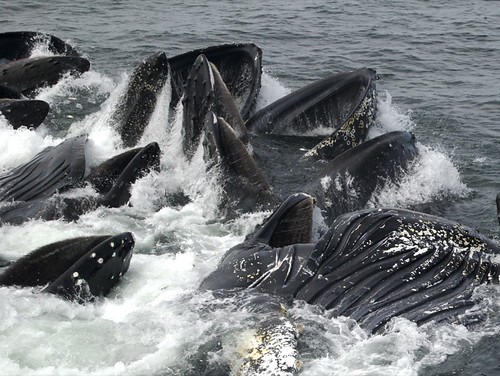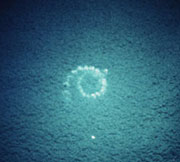Is there anyth ing in the world that we can claim to be perfectly designed? I truly believe so. The world itself - barring poorly executed deep water oil drills and wars faught over petty issues born from our immaturely-developed Ego - is a triumph of design, whether you are a person of faith or not. Over the course of billions and billions of years, the earth has been going through the process of natural selection - from the first proteins that became attracted to each other, to the development of the perfectly deceptive and deadly pitcher plant of today. Natural selection is the ultimate critical process - any genetic feature of an animal or plant that is NOT the most advantageous will eventually be weeded out of the gene pool, simply by virtue of having a slightly lower reproductive rate. It's a very slow process, but it is responsible for some of the weirdest and most specialized designs adapted to survive in inhospitable conditions. Pictured left is the famous star-nosed mole, a small and totally blind rodent that has evolved a spectacularly grotesque nose packed with over 25,000 sensory receptors in order to feel with
ing in the world that we can claim to be perfectly designed? I truly believe so. The world itself - barring poorly executed deep water oil drills and wars faught over petty issues born from our immaturely-developed Ego - is a triumph of design, whether you are a person of faith or not. Over the course of billions and billions of years, the earth has been going through the process of natural selection - from the first proteins that became attracted to each other, to the development of the perfectly deceptive and deadly pitcher plant of today. Natural selection is the ultimate critical process - any genetic feature of an animal or plant that is NOT the most advantageous will eventually be weeded out of the gene pool, simply by virtue of having a slightly lower reproductive rate. It's a very slow process, but it is responsible for some of the weirdest and most specialized designs adapted to survive in inhospitable conditions. Pictured left is the famous star-nosed mole, a small and totally blind rodent that has evolved a spectacularly grotesque nose packed with over 25,000 sensory receptors in order to feel with
great detail the subterranean world around it. ing in the world that we can claim to be perfectly designed? I truly believe so. The world itself - barring poorly executed deep water oil drills and wars faught over petty issues born from our immaturely-developed Ego - is a triumph of design, whether you are a person of faith or not. Over the course of billions and billions of years, the earth has been going through the process of natural selection - from the first proteins that became attracted to each other, to the development of the perfectly deceptive and deadly pitcher plant of today. Natural selection is the ultimate critical process - any genetic feature of an animal or plant that is NOT the most advantageous will eventually be weeded out of the gene pool, simply by virtue of having a slightly lower reproductive rate. It's a very slow process, but it is responsible for some of the weirdest and most specialized designs adapted to survive in inhospitable conditions. Pictured left is the famous star-nosed mole, a small and totally blind rodent that has evolved a spectacularly grotesque nose packed with over 25,000 sensory receptors in order to feel with
ing in the world that we can claim to be perfectly designed? I truly believe so. The world itself - barring poorly executed deep water oil drills and wars faught over petty issues born from our immaturely-developed Ego - is a triumph of design, whether you are a person of faith or not. Over the course of billions and billions of years, the earth has been going through the process of natural selection - from the first proteins that became attracted to each other, to the development of the perfectly deceptive and deadly pitcher plant of today. Natural selection is the ultimate critical process - any genetic feature of an animal or plant that is NOT the most advantageous will eventually be weeded out of the gene pool, simply by virtue of having a slightly lower reproductive rate. It's a very slow process, but it is responsible for some of the weirdest and most specialized designs adapted to survive in inhospitable conditions. Pictured left is the famous star-nosed mole, a small and totally blind rodent that has evolved a spectacularly grotesque nose packed with over 25,000 sensory receptors in order to feel with"Nature's concern is for the most economical management of the overal system ... this approach to design seeks to adapt specific advantages observed in natural organisms into human technology"
 Other examples of great natural design are the balleen whales, who despite their enormous size have been designed not only to survive as entirely aquatic mammals, but have developed an in-mouth straining system and a pleated, expandable belly in order to suck in great volumes of plankton-rich water which is then strained through their balleen. Every feature of every animal we encounter is a finely-tuned design, a design that has been tried and tested over an unimagineable amount of time.
Other examples of great natural design are the balleen whales, who despite their enormous size have been designed not only to survive as entirely aquatic mammals, but have developed an in-mouth straining system and a pleated, expandable belly in order to suck in great volumes of plankton-rich water which is then strained through their balleen. Every feature of every animal we encounter is a finely-tuned design, a design that has been tried and tested over an unimagineable amount of time.With an understanding of the reach and complexity of natural adaptations to cruel natural problems, it's not a stretch then to understand the importance of looking to nature as a resource for solving some of our manmade problems. There are already numerous examples, some of which have been mentioned in Aldersey-Williams' essay. Other notable examples of this design-from-nature principle are things like the development of kevlar fibres mirroring closely the structure of spider silk, and, relevant to our course, the study of the way in which termite mound design and composition reduces the temperature of the colony in order to apply this knowledge to contemporary building design.
Aldersey-Williams draws a connection between Charles Eames and Richard Feynman; two men who could both be considered "designers" in the context that I stated at the top of this post. They were separated by discipline and, because of this, did not have the opportunity to discuss the parallels present in their work regarding the concept of harmonious design, and to bring understanding to complex and seemingly mysterious processes. I will, as the author of Applied Curiosity has, the necessary issue of consilience -
"the reunification of the strands of intellectual inquiry artificially separated as a consequence of the growth of specialized disciplines in science and the humanities"
We've touched on this issue before, and I think it is a pressingly important problem that needs solving. Engineers and scientists know how to make a complex and functional machine; designers know how to make that machine easy to integrate into the lives and behavior of the people it is destined to serve. Scientists amass vast amounts of data about the deteriorating environment, but designers are the ones truly responsible for communicating this information to the ignorant masses in a format that is easy to digest.
One final question to you... is biomimicry - the study of natural design in order to emulate a man-made version for our benefit - post-modern? If so, the irony is palpable.

I really enjoyed reading this! Thanks.
ReplyDeleteOne question popped into my head while reading it.... "Why do we consider "man-made problems" unnatural?
The other thing that I always find interesting is thinking of "Natural Selection" as a being's ability to adapt to its environment. This is "natural". So how can desingers help us adapt to our new and emerging landscape? I think the possibilities are endless!